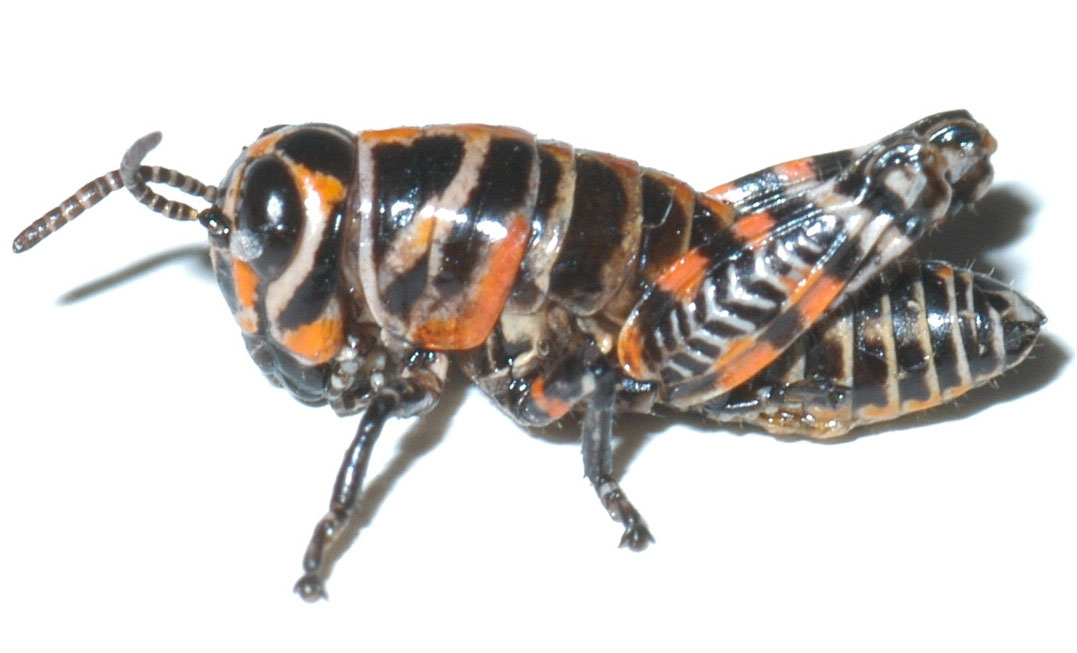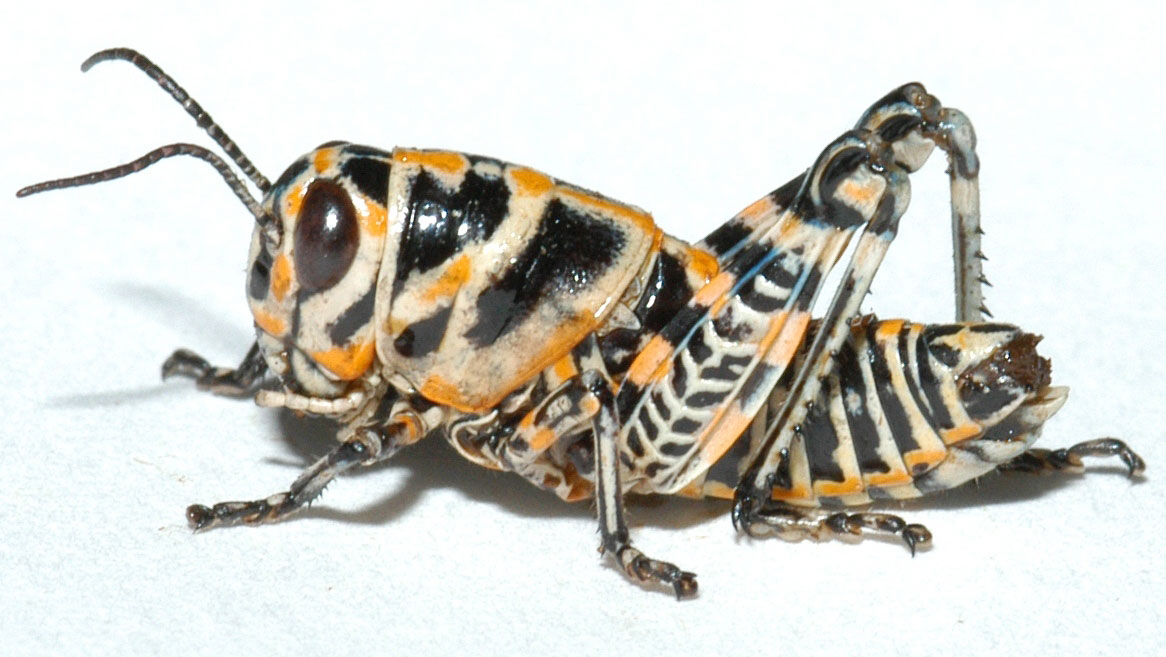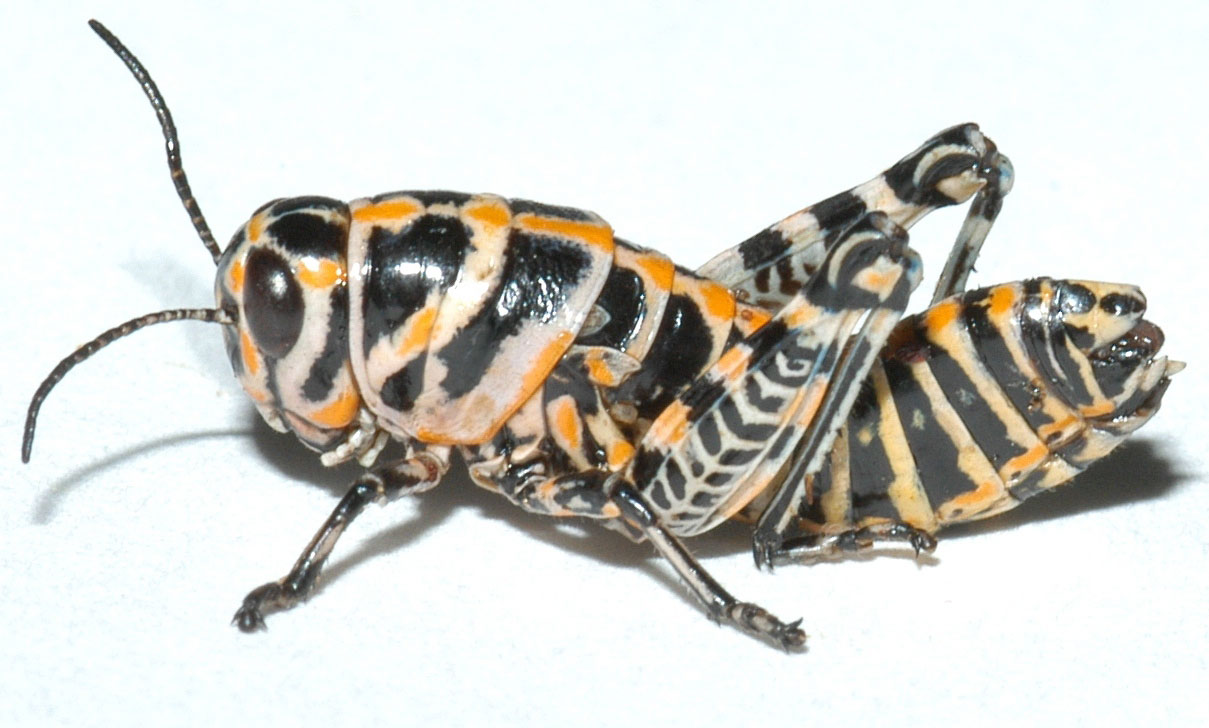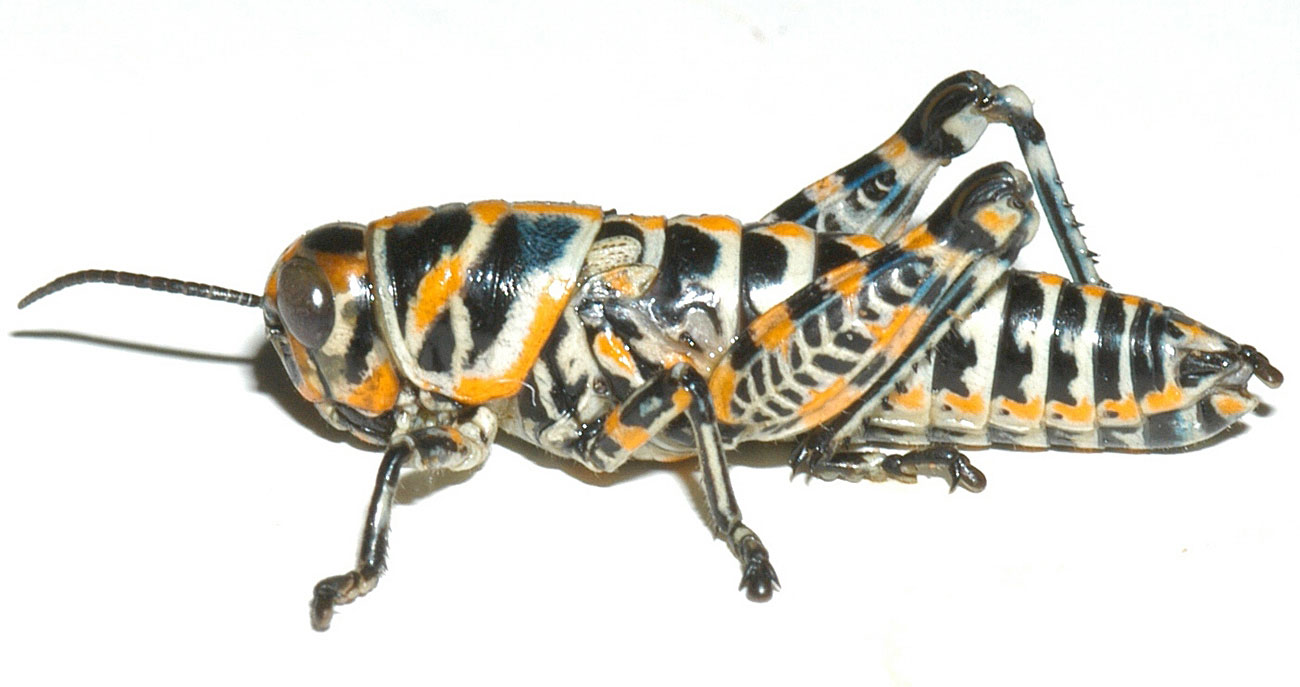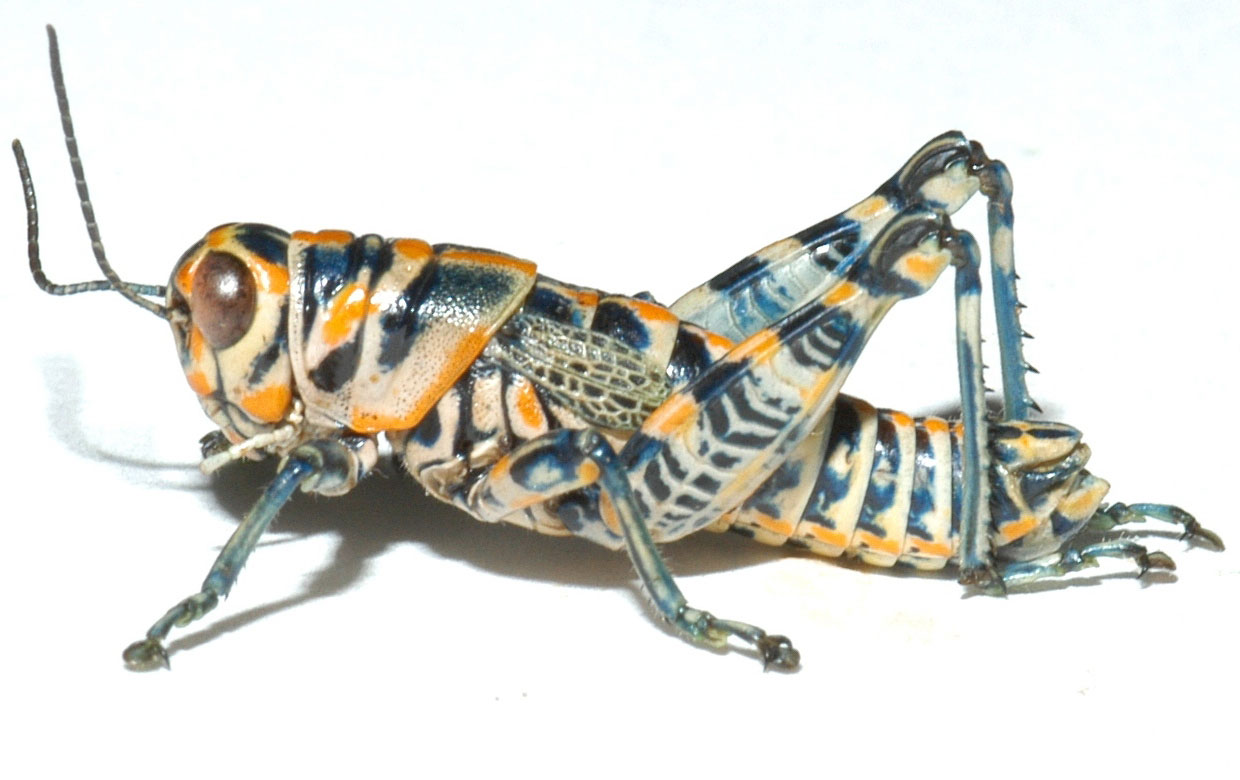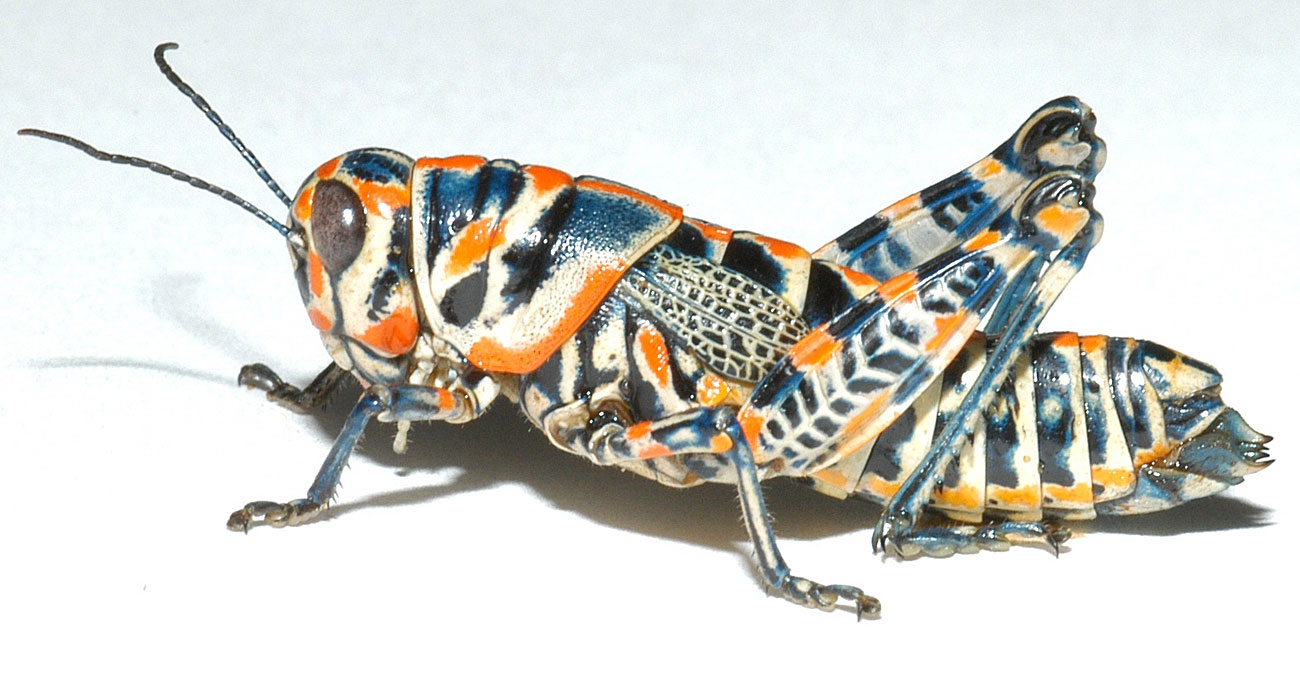Dactylotum bicolor
|
Geographic range of Dactylotum bicolor (Thomas) |
|
Fig. 1, second instar |
|
Fig. 2, third instar |
|
Fig. 3, fourth instar |
|
Fig. 4, fifth instar |
|
Fig. 5, adult male: BL 20-25 mm, FL 11-13 mm, AS 23-25 |
|
Fig. 6, adult female: BL 27-35 mm, FL 13-15 mm, AS 23-25 |
Species
Painted grasshopper
Dactylotum bicolor (Thomas)
Subfamily Melanoplinae
Identification
Adults of the painted grasshopper are unmistakable. Both sexes are boldly marked with bands of dark blue to blackish, orange, and yellowish to white. There are two dark bands on the pronotum one of which is largely contiguous with one on the side of the face. Another pair of dark markings is evident on the top of the head, and each abdominal segment is dark basally, with whitish toward the rear. Orange markings are scattered in a variety of areas, but consistent in location. The hind femur is marked with four dark blue to blackish bands on the outer surface, and these may merge into one another. The areas between these bands are largely orange and whitish. The inner hind femur is also banded in dark blue to blackish and orange. The hind tibia is largely dark bluish, with a whitish ring near the base. The blue often fades to whitish in the vicinity of the spines, and the spines are dark. Females are significantly larger than males.
Distribution and habitat
The painted grasshopper occurs from northern Texas and New Mexico to Nebraska and Montana. It occurs primarily in short-grass habitats with relatively sparse vegetation. It is seldom found in large numbers and single individuals are often noted among sparse weedy vegetation in eroded habitats, especially on hillsides.
Economic importance
As this grasshopper feeds primarily of forbs and because it is typically uncommon, it is not expected to pose a threat to rangeland.
Food preferences
The painted grasshopper feeds on a variety of grasses and forbs in sparsely vegetated areas with little preference for any species. Grass species recorded in crop analyses included Agropyron smithii, Bromus tectorum, Festuca octoflora, and Panicum capillare. At least 14 forbs were recorded in crop analyses.
Dispersal and migration
Adults of this grasshopper have short wings and are unable to fly. Migration is likely limited to short distances.
Hatching
This grasshopper is probably in the intermediate hatching group. Its development is poorly known but eggs likely hatch from areas of bare soil.
Nymphal development
The nymphal development of the painted grasshopper has not been studied. Nymphs probably develop through five instars, with females potentially requiring six. In Nebraska, nymphs have been found mostly in May and June.
Adults and reproduction
Adults of the painted grasshopper remain in the same areas in which nymphs are found. Adults are most numerous from late July to September. Egg pods consist of 15 to 25 eggs, arranged in three or four disorderly columns. Eggs are 5.3 mm in length, 1.4 mm in diameter, and brownish yellow in color. They are presumably deposited in areas of bare soil near sparse vegetation. The courtship of this grasshopper has not been studied. Adults are generally uncommon, tend to be localized in areas of sparse vegetation, and are somewhat clumsy.
Population ecology
The population ecology of this grasshopper has not been studied. Populations in Nebraska do not appear to fluctuate dramatically from year to year and this species is generally always uncommon.
Daily activity
The daily activity of the painted grasshopper has not been studied. It has been observed feeding during the afternoon hours on relatively hot days, elevated within small clumps of grasses.
Source and date
University of Nebraska by Mathew L. Brust March 2007
Selected references
Hebard, M. 1925. The Orthoptera of South Dakota. Proceedings of the Academy of Natural Sciences, Philadelphia 77: 35-155.
Helfer, J. R. 1987. How to Know the Grasshoppers, Crickets, Cockroaches and Their Allies. Dover Publications Inc. New York, New York. 363 pp.
Mulkern, G. B., K. P. Pruess, H. Knutson, A. F. Hagen, J. B. Campbell, and J. D. Lambley. 1969. Food habits and preferences of grassland grasshoppers of the north central Great Plains. North Dakota State University Agricultural Experiment Station, North Central Regional Publication no. 196. 32 pp.
Onsager, J. A., and C. B. Mulkern. 1963. Identification of eggs and egg pods of North Dakota grasshoppers (Orthoptera: Acrididae). North Dakota Agriculture Experiment Station Bulletin 446: 1-48.

